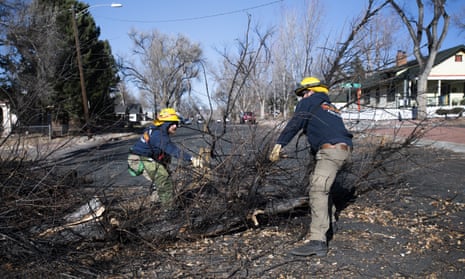Less than a week after a swarm of powerful tornadoes devastated Kentucky and four other states, a freakish wind storm has brought “Dust Bowl” conditions and gusts of more than 100 mph to parts of the Great Plains and upper midwest, meteorologists said on Wednesday.
The low pressure wind system, driven by unseasonably high temperatures, closed highways in western Kansas, spawned reported tornadoes in Nebraska and Iowa and raised concerns about fires because of the unusual heat.
The powerful storm system triggered power outages in four US states, including more than 100,000 homes and businesses in Colorado by Wednesday evening.
The winds whipped up dust that reduced visibility to zero west of Wakeeney, Kansas, according to state officials, and caused at least four semitrailers to blow over. Kansas officials closed Interstate 70 from the Colorado border to Salina, as well as all state highways in nine counties in north-west Kansas.
The National Weather Service said there have been 13 tornado reports in the Plains states, scattered through eastern Nebraska and Iowa. Winds topped 70 mph through much of Kansas, Nebraska and Iowa.
“To have this number of damaging wind storms at one time would be unusual anytime of year,” said Brian Barjenbruch, a meteorologist with the National Weather Service in Valley, Nebraska. “But to have this happen in December is really abnormal.”
A colossal Great Plains dust storm.
— Dakota Smith (@weatherdak) December 16, 2021
Incredible imagery. pic.twitter.com/zjH8kkHLjI
The storm system could also pummel the region with thunderstorms and snow, the National Weather Service said in an advisory.
“There have been historic ‘Dust Bowl’ conditions with no visibility in parts of New Mexico and Colorado,” said Marc Chenard, a forecaster for the National Weather Service’s Weather Prediction Center in College Park, Maryland.
“This is highly unusual,” Chenard said. “It’s shifting east and is unusual for this large of an area, it will be going through the Great Lakes area, Michigan and into Canada by Thursday morning,” he said.
The system came on the heels of devastating tornadoes last weekend that cut a path through states including Arkansas, Missouri, Tennessee, Illinois and Kentucky, killing more than 85 people.
Joe Biden toured the hard hit communities on Wednesday, saying he had “not seen this much damage from a tornado” before.
The National Weather Service issued a high wind warning for an area stretching from New Mexico to upper Michigan, including Wisconsin and Illinois. Gusts topping 80 mph were recorded in the Texas Panhandle and western Kansas. The weather service said an automated observation site in Lamar, Colorado, recorded a gust of 107 mph Wednesday morning. Wind gusts of 100 mph were reported in Russell, Kansas.

Greg Butcher, the city administrator in Seward, Nebraska, said he was standing in his office at city hall Wednesday when he saw a giant wall of cloud rolling toward him. Butcher said he braced for a major hit but so far the worst damage appears to be a few toppled telephone poles.
“We lucked out,” Butcher said. “It came in really fast.”
Scientists say extreme weather events and warmer temperatures are more likely to occur with human-caused climate crisis.
“I think we also need to stop asking the question of whether or not this event was caused by climate change. All events nowadays are augmented by climate change,” said Victor Gensini, a meteorology professor at Northern Illinois University. “We need to be asking, ‘To what extent did climate change play a role and how likely was this event to occur in the absence of climate change?’”
